Photos and text by James Occi

In this photo we have a wheel bug, (Arilus cristatus) Order Hemiptera, Family Reduviidae, feeding on a spotted lanternfly, Lycorma delicatula, Order Hemiptera, Family Fulgoridae.
A major characteristic of the Hemiptera is the presence of sucking mouth parts. Some feed on plants such as the spotted lanternfly, some are insectivorious such as the wheel bug. The wheel bug is literally sucking the juices out of the spotted lanternfly.
The wheel bug is indigenous to North America, while the spotted lanternfly is an invasive species, indigenous to China and was first found in Pennsylvania in 2014. It is interesting to note that the spotted lanternfly often feeds on the tree of heaven (Ailanthus altissima), another invasive species found in the US. However, the spotted lanternfly will feed on other plants such as fruit trees and grapes and lead to considerable damage that may impact food prices and contribute to food insecurity.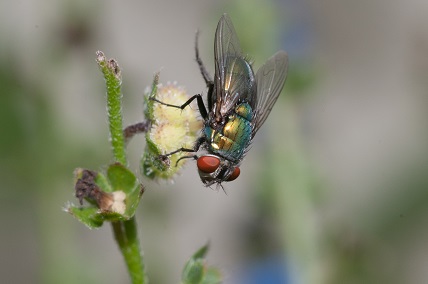
This time we feature the common green bottle fly, Lucilia sericata (Order Diptera, Family Calliphoridae). Its most noticeable feature is the metalic-green thorax and abdomen.
This species is found world wide and is commonly found on manure and decomposing animals, where the female can lay hundreds of eggs.
It is one of the first species of flies to arrive at a corpse and can assist in estimating time of death in human forensic studies.
A company in the UK is harnessing the antibacterial and antifungal compounds secreted by these flies and developing them for clinical use. They also raise larvae for "maggot therapy" - the use of larval L. sericata to consume necrotic tissue in wounds.
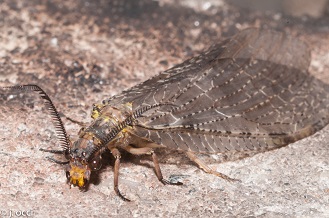
This time we feature what is commonly known as a fishfly. It is not a true fly but placed in the Order Megaloptera, family Corydalidae—a grouping that also contains adlerflies and dobsonsflies. Female fishflies lay egg masses on vegetation that overhangs water. When the larvae (sometimes referred to as hellgrammites) hatch, they fall into the water and develop into larvae. Larvae are omnivorous and will feed on small invertebrates as well as vegetation. The pupae will crawl onto the banks, find or excavate a small hole and then metamorphose into adults. This group of insects prefers to be near aquatic habitats but adults are attracted to light (which is how this specimen was found).
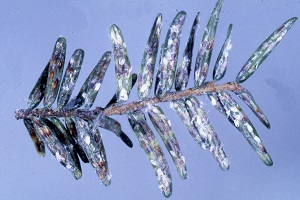
The hemlock wooly adelgid (HWA), Adelges tsugae, is another example of a species introduced into the United States. It is a native Japan and like most invasives—here in the US has very few natural predators. This sucking insect (order Hemiptera, suborder Sternorryncha) sucks the sap from hemlock and spruce trees. The HWA was first found in Virginia in the 1950s but has been on the west coast much longer. It is interesting to note on the west coast, the HWA does not cause as much damage. There it feeds on the western hemlock, while on the east coast, if feeds on the eastern hemlock and the Carolina hemlock. The HWA has a complicated life cycle that involves hemlock as well as spruce trees. On eastern hemlock, HWA produces two generations a year, an overwintering generation (sistens) and a spring generation (progrediens). These two generations overlap in the spring. The progrediens has two forms: a wingless form that remains on the hemlock and a winged form (sexuparae) that flies in search of a suitable spruce tree upon which to start a sexual reproductive cycle. This image features the egg masses (white fluff) on an eastern hemlock. The State of New York has a very informative website if you need additional information.
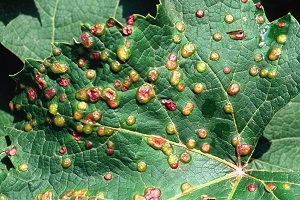
Grape phylloxera is an insect infestation of grapes. The causative insect is Daktulosphaira vitifoliae in the order Hemiptera and is indigenous the eastern US. This insect has one of the most complex life cycles known and involves five "forms" called: asexual form, sexual form, leaf form, root form, and winged form. The sexual form (male and female adults) emerge from eggs laid on the underside of young grape leaves. When the male and female mate, the female lays “winter” eggs on the bark of the grape’s trunk. Nymphs that develop from the winter eggs become a leaf form. Adult females that develop from these nymphs lay parthenogenetically generated eggs on the leaves and the galls are formed when she injects saliva. The nymphs that hatch from these eggs can move to other leaves or the roots. The root form can destroy the root structure. During the mid-late 1800's this pest was unknowingly exported from North America into Europe by French vintners looking for new grape varieties. This introduction almost destroyed the entire French wine industry. Some vineyards were completely wiped out. The French noted that: "the phylloxera preferred the leaves of imported American vines, and the roots of local French vines.”* Today, most French grape varieties are grafted onto American grape root stocks.
*Read more at the Smithsonian Magazine
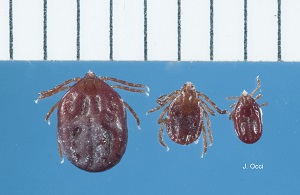
This month we feature another invasive species, the three-host tick, Haemaphysalis longicornis. A multigenerational infestation of this species was detected in Hunterdon Co. last summer by Tadhgh Rainey (a Rutgers Entomology graduate student!) and IDed using a DNA based approach by Andrea Egizi, also a Rutgers graduate. Some common – and possibly misleading—names are “bush tick” and “long-horned tick”. In New Zealand and parts of Australia, where it was introduced over 100 years ago presumably from Japan, it is called the “New Zealand cattle tick” as it is the only tick feeding on cattle. Originally from northeast Asia (China, Korea, SE Russia, Japan), this tick is commonly found on cattle, sheep, deer and medium-sized mammals. And because it feeds very successfully on large, domestic animals, it is potentially a very big problem for the livestock industry. The other problem is that some populations of this tick are parthenogenetic, which means males are not necessary. Parthenogenesis allows infestations to quickly reach very large numbers—so much so that in certain settings, host animals are weakened by the blood loss. The extent of infestation in NJ/US is still not known. Multiple agencies are currently addressing this issue and we should no more by spring. In this image, there are two females (left and middle) and a nymph on the right (scale in mm). For more information see: fonseca-lab.com/research/global-health-the-tick-that-binds-us-all.
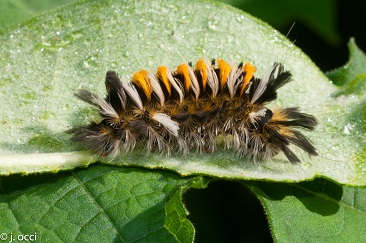
This month we feature the milkweed tussock caterpillar, Euchaetes egle. Like many other insects it takes advantage of the cardiac glycosides in milkweed sap to protect itself. The aposematic (warning) colors of this species remind any potential predator that it will not taste very good. In addition to the coloration, there are very elaborate tufts of hair that no doubt deter potential predators. They may be observed eating in large groups as early instars but become less gregarious in later stages.

In an attempt to photograph “green bottle flies” for our very own Board Certified Forensic Entomologist, Denise Gemmellaro, I also encountered a robber fly. Robber flies (Order Diptera, Family Asilidae) are, as the name suggest, predatory. Robber flies are agile enough to capture their prey in flight at which point they can inject paralyzing saliva that also contains digestive enzymes. Robber fly mouthparts are designed for drawing up liquid as the proteolytic enzymes digest their prey. As for the victim here, the Common green bottle fly is also a Dipteran but in the Family Calliphoridae. They are sometimes called blow flies and are one of the first insects to arrive at the scene of a dead animal. In fact they are very important in helping forensic entomologists estimate the time since death in situations where a body is found and no situational information is available.

It's early July and so we turn our attention to the lone star tick, Amblyomma americanum. In New Jersey most tick-conscious people think about deer ticks (Ixodes scapularis) and American dog ticks (Dermacentor variabilis), but in the southern part of the state, the lone star tick (LST) is more commonly encountered based on public submissions to the Ocean County Master Gardeners and Monmouth County Mosquito Control Commission. The LST is an aggressive tick that will feed on anything. In addition, it will actually move towards a host as opposed to most ticks that just wait for the host to come to it. Lone star ticks can also transmit pathogens to whatever it is feeding on—including humans. Lone star ticks can transmit Ehrlichia chaffeensis and E. ewingii to humans and pets as well as the agents of Rocky Mountain spotted fever and tularemia. This image features a female lone star tick (left), a male (middle) and a nymph (right) collected in Ocean County, NJ (top ruler in mm, bottom ruler in 16ths of an inch).
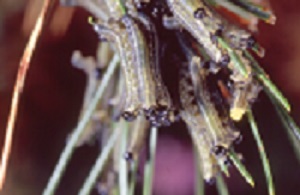
Now that most plants are in full swing after a winter dormancy, we have to watch for what follows. Insect pests. Many of our agriculture and forest pests are foreign invaders—invasive species, if you will. Some hitched a ride from other continents on ships, some on planes and some even on people. Today's garden pest is the European sawfly, Neodiprion sertifer. The specimens featured here are munching away on my dwarf mugo pine. Although they look like caterpillars (Lepidoptera) sawflies are in the order Hymenoptera—the same group as bees, wasps and ants. As I approached to take their photograph, these larvae reared back by arching their bodies and then whipped forward towards the threat (me). There are glands on their anterior segments that release volatile compounds when the hydrostatic pressure is generated by their whipping motion. I never felt or saw any of these compounds, but they surely destroyed my mugo pine.
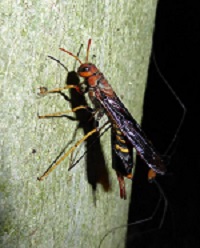
Last time we described the parasitoid ichneumonid wasp. This time we will delve into the host of that parasitoid: the pigeon horntail, Tremex columba. The female horntail usually lays eggs in hardwood trees such as maple, ash and elm. Most of the time the wood that is chosen is already in decline and thus the horntail is not considered a serious pest. The interesting thing is that when the female deposits here eggs, she also inoculates the egg with white rot fungus, Cerrena unicolor. The female horntail has a special gland in her abdomen which contains spores of the fungus. When the egg passes out her ovipositor, it picks up a load of spores on its way out. Not only does the fungus help decompose the wood, but the larva horntail uses the fungal hyphae as a food source. It is thought that the ichneumonid wasp can locate the horntail larva by detecting a pheromone released by the fungus. This has never been published, but it makes a great story! Some also believe that the ichneumodi wasp finds the horntail larva by detecting vibrations in the wood. See also this article. (PDF)

Here we feature the ichneumonid wasp, Megarhyssa macrurus. These wasps are in the order Hymenoptera, family Ichneumonoidae. The ichneumonids are called parasitic wasps but they are actually parasitoids. They are called this because they are free living as adults but their young develop on or in another organism, killing it in the process. This specimen is a female M. macrurus and is attempting to lay an egg on a host that lives under the bark of a tree using her extremely long ovipositor. The victim of this relationship is a larval horntail—another member of the Hymenoptera, which feeds on the cambium under the bark of the wood. The ichneumonid wasp will lay an egg on or near the horntail larva and the larva that hatches from the egg will develop as it feeds on the horntail larva. Next time we will feature the horntail which has a very unique way of burrowing into the wood.

Fleas are wingless insects in the order Siphonaptera (siphon =sucking, aptera = wingless) and are of great economic importance. The oriental rat flea, Xenopsylla cheopis, for example is known as a major vector of the plague bacterium, Yersinia pestis. In the 1300s, plague was responsible for the death of 30-50% of Europe's population in an epidemic known as the Black Death. X. cheopsis picks up Y. pestis when feeding on infected rodents. If the flea becomes infected, it can transmit the bacterium to a new host. Another indication of their importance is the fact that pet owners in the US spend $379.1 million on flea (and tick) products every year.Adult fleas are laterally flattened so that they can traverse the hair of their hosts. Some flea-host relationships are highly specific,while others feed as generalists. For example, the squirrel flea (Orchopeashowardi) is commonly found on squirrels, while the cat flea (Ctenocephalidesfelis) will feed on cats, dogs and humans. On that note, it should be mentioned that most flea infestations of dogs is by the cat flea and not the dog flea (Ctenocephalidescanis). Most fleas are associated with rodents and medium-sized mammals and are nidicolous—they remain in and around the nest of their hosts when not feeding. And it is only the adult stage that takes a blood meal from hosts. This image is the adult of a species of Epitedia removed from a vole in Oregon, photographed through a Nikon Coaxial microscope (4x objective) with a Nikon D300 DSLR attached to the camera mount.
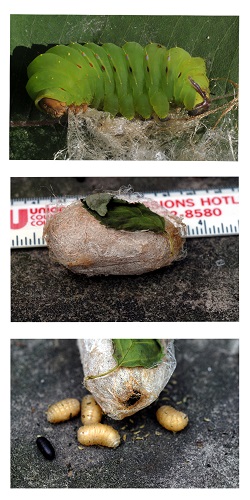
Here we feature the larval and pupal stages of the luna moth, Actias luna. These large moths are in the order Lepidoptera, family, Saturniidae. My hopes of raising this pupa to adulthood were quashed when I found these parasitoids emerging from the pupal case. Dr. David Moskowitz, bugman extraordinaire, suggests that the dark brown oval is a fly puparia and the larvae look to be emerged Tachnid flies (order Diptera family Tachanidae). Unfortunately this is a common fate of many luna moths. Apparently, parasitoid insects were imported into the US in order to control the (imported) gypsy moth. In a perfect example of two wrongs don't make a right, not only are gypsy moths doing well, the luna moth has been in decline in some areas because of these parasitoids. See Kellog et al [Environ. Entomol. 32(5) (2003)] for more information on this topic.
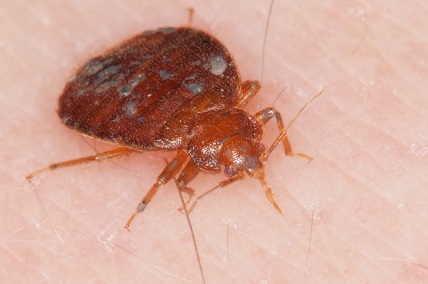
"Sleep tight and don't let the bed bugs bite" was a common phrase growing up. Of course we all thought it was just a saying. As children in the post-war (WWII) generation, we never heard of real bed bugs. And then things changed. Global trade, global travel, improper use of insecticides and now we have a bed bug problem. Cimex lectularius is the scientific name of our everyday (or more appropriately “every night”) bedbug. They are in the Order Hemiptera, family Cimicidae. One of the most common features of this order is a proboscis modified for drawing fluids from hosts. Bed bugs are obligate blood-feeding insects and all stages and sexes feed on blood (except the egg stage of course). Here we have a specimen preparing to feed on my arm. Bed bugs are usually nocturnal and rarely seen. Many times infestations are only discovered when victims observe their tell-tale signs: bite marks, bug "dirt" and exuvia on sheets and in nooks and crannies. So if one suspects a bed bug infestation, check the baseboard molding and under the mattress and sofa cushions. If an infestation is discovered, one needs to call a bed bug-experienced exterminator. For further information, consult the experts of Dr. Changlu Wang's lab. Dr. Amada Eiden kindly supplied the specimen in this photograph.
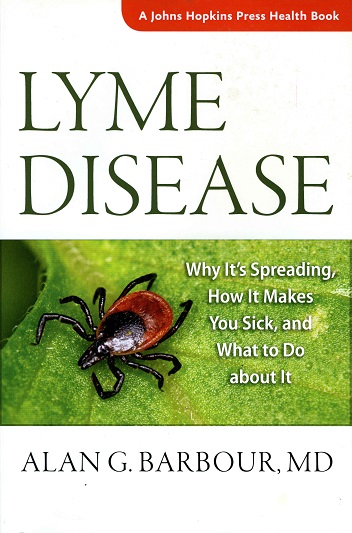
Now that the cooler temperatures have arrived, most arthropods numbers decline and initiate their overwintering strategies. One arthropod that has just started to emerge is the adult stage of the blacklegged (aka deer) tick, Ixodes scapularis. Female I. scapularis usually feed on medium to large animals. More to the point, adult blacklegged tick emergence coincides with the white tailed deer mating season. These ticks use the large mammals as a mating and feeding grounds—yes, adult I. scapularis will feed and mate simultaneously. Keep in mind that this is the same species of tick that transmits the Lyme spirochete. Most cases of human Lyme disease are transmitted by the nymphal stage which emerge in early summer and are much smaller. But one can still contract Lyme disease in the fall if bitten by an infected female (the males don't usually feed). Today's featured image—a female I. scapularis on a leaf—was used for the cover of Alan Barbour's new book on Lyme Disease (Johns Hopkins Press, 2016).
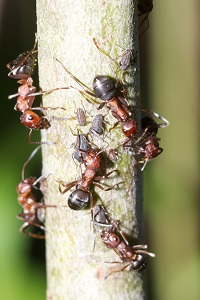
Last time we featured aphids. This time we feature ants and aphids. These specimens were photographed at Stokes State Forest (northern New Jersey) in September of this year. The ants are tending to their aphids. Pairs of ant and aphid species have mutualistic relationships where each species has a positive effect on the other. Specifically, the ants protect the soft-bodied aphids from predators and the aphids provide honeydew to the ants. Honeydew is the sugar-rich liquid secreted by the aphids as they draw carbohydrate-laced fluid from the phloem of their host plant. It has been observed that in some ant-aphid relationships, the ants will "milk" their aphids in order to stimulate honeydew secretion. A very detailed review by Stadler and Dixon explains the cost/benefit ratio of these relationships for each player (Stadler 2005 Ann Rev Ecol Evol Syst 36:345-72).

This time we feature aphids feeding on a milkweed plant. Aphids are insects in the Order Hemiptera, Family Aphididae. This invasive species is Aphis nerii - the oleander aphid—and probably originated in the Mediterranean. These aphids reproduce parthenogenetically in the spring and summer. In the fall males and females will mate to produce overwintering eggs. Although many individuals in this image are wingless, aphids can produce winged adults based on density, seasonal cues as well as when changing host plants. When feeding on milkweed the aphids ingest the cardiac glycosides which protect them from predation due to the toxicity. The yellow color is also thought to be warning coloration. Finally, aphids helped botanists differentiate between the two major vascular tissues in higher plants as aphids preferentially feeds on phloem, eschewing the xylem.
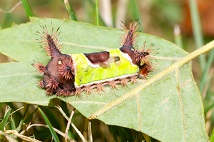
In this image we feature the saddleback caterpillar. The larval form of a so-called slug moth or limacodid moth. This species is Acharia stimulea, although one may see the synonym, Sibine stimulea, in the literature. Unlike most larval lepidopterans that humans encounter, this species can provide quite a sting by virtue of their urticating hairs or spines. The spines are the vehicle for a hemolytic venom as well as another venom that can cause vesicles to form on the skin of the victim. At times the spines will break off and remain in the victim. They need to be removed immediately to reduce the severity of the damage. This particular specimen is a late stage instar and was feeding on the underside of a birch leaf—one of its many foods as this species will feed on almost anything. Here is a very informative link, including references from the University of Florida.

This time around we feature the large milkweed bug, Oncopeltus fasciatus. This particular image is of the nymphal stage. They are members of the true bugs (Order Hemiptera) which includes aphids and cicadas. Here they are feasting on milkweed seeds. The nymphs inject saliva into a seed which pre-digests the seed material. Next the bug draws up the pre-digested meal. In doing so the insects also take in chemical components of the milkweed plant, the cardiac glycosides. The insects store the glycosides in their bodies so that any predators get a dose—which probably tastes bad, but more importantly is toxic. Chemical ecology, as this field is called is nicely reviewed by Agrawal et al (New Phytologist (2012) 194:28–45.
This time we feature the American cockroach, Periplaneta americana. Other common names are water bug and palmetto bug. Cockroaches are in the order Blattodae, family Blattidae. This species probably originated on the African continent but now has a world wide distribution. It is closely associated with human habitation and will feed on just about anything. Although commonly thought to be "carriers of disease", they have not been implicated to vector (directly transmit) any infectious agents to humans. They may contaminate food with their excreta, which may result in infections, but they do not directly transmit anything by biting. In fact, they usually run when disturbed and exhibit positive thigmotaxis, which means they usually walk along a wall where it meets the floor.
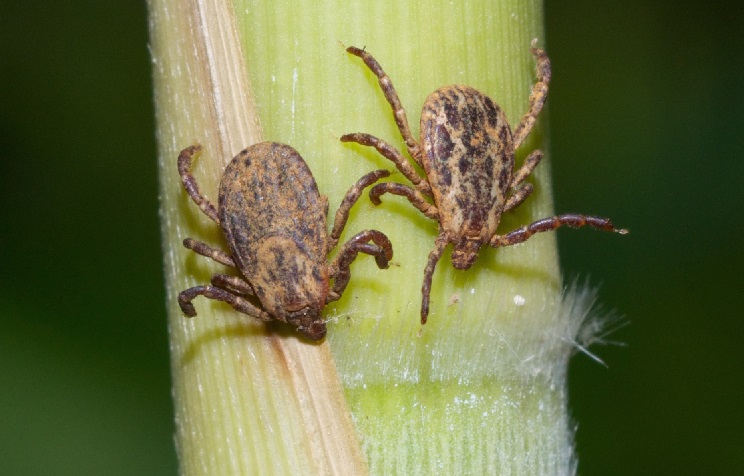
This week we feature another arachnid. These are questing American dog ticks, Dermacentor variabilis. Questing is when ticks wait on vegetation for a potential host to walk by. When the tick comes in direct contact with the host, it clamps on and goes for the ride. It will eventually begin feeding once it finds a "good location". Ticks can't hop, skip, jump or fly—they have to have direct contact with the host. D. variabilis, like all ticks, needs a blood meal to develop into the next stage or to mate and lay eggs in the case of a female. And like many ticks, they can sometimes transmit infectious agents during that blood meal. D. variabilis can transmit the agent of Rocky Mountain spotted fever (Rickettsia rickettsii) and tularemia (Francisella tularensis). In New Jersey, the risk is very low, but one should be aware of that possibility if bitten. This photo was taken at Shark River park in early June. These individuals (female on the left and male on the right) probably just emerged from the winter diapause where they developed over the fall, winter and early spring from nymphs. And I say "just emerged" because they are still covered in mud. Some semantics on the naming of ticks. The official common name for D. variabilis is American dog ticks. Can dog tick be used? Not really because there is also the brown dog tick, Rhipicephalus sanguineus, which will be featured at a later date. Finally a public service announcement: Whenever you venture into the woods, do a tick check when you return home.
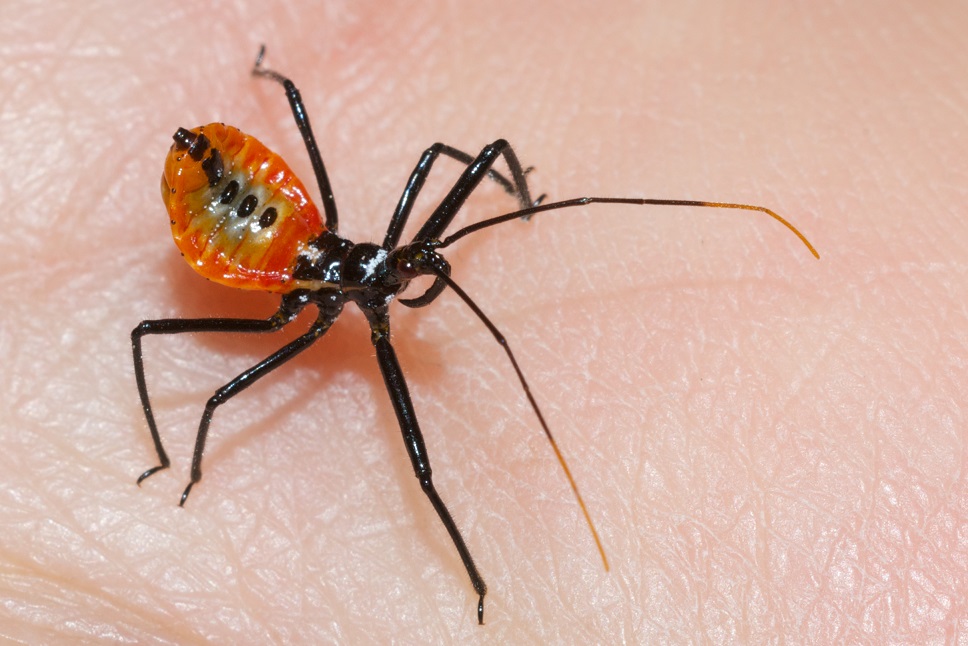
This week we feature a nymphal wheel bug, Arilus cristatus. The common name comes from the "wheel" (it actually looks like a cog) on the dorsum of the adult. These are true bugs in the order Hemiptera, family Reduviidae. The common name for the family is Assassin Bugs. These insects are predatory and pierce their prey with the proboscis. Unbeknownst to me (the photographer) they also bite in self-defense. The bite can be quite painful. In the New World tropics and parts of the southwestern US one group of Assassin bugs are called kissing bugs or Triatoma sps. Many species of Triatoma transmit a protozoan called Trypanosoma cruzii, the causative agent of Chagas disease or American Trypanosomiasis. They are called kissing bugs because many times they bite around the mouth of their victims while they are sleeping. When feeding (or shortly thereafter) they release the trypanosome when they defecate. Some species of trypanosome-competent Triatoma exist in the southern United States. Fortunately, this species (photographed in Ohio) is not considered one of them.
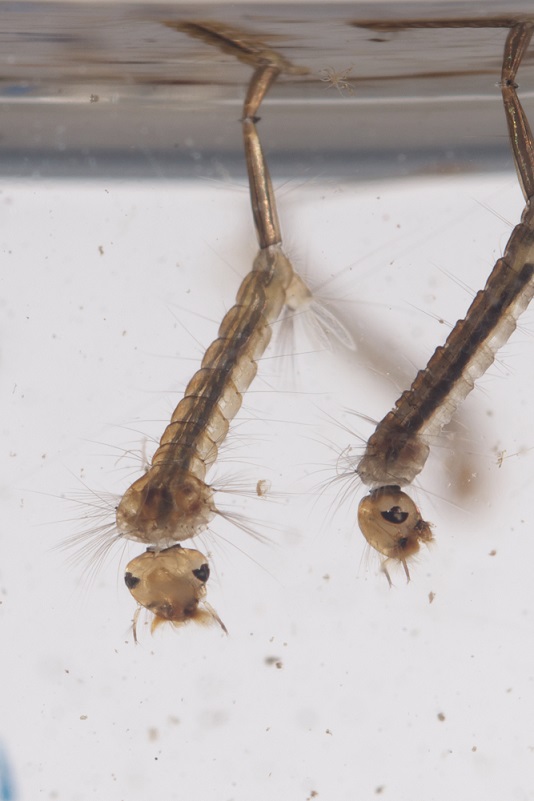
It's that time of year again. Mosquito season. This image feature mosquito larvae of the genus Culex, which are vectors of West Nile virus. These and other invasive mosquitoes like those that vector the Zika virus, thrive in your yard. Everyone needs to be vigilant about removing standing water from flower pots, clogged gutters and even plastic corrugated downspouts. Gravid (mated and blood-fed) females lay eggs near/on water. Larvae hatch and in approximately 7-10 days (depending on species and ambient conditions), adult mosquitoes emerge. So in order to fight the bite, dump the water.
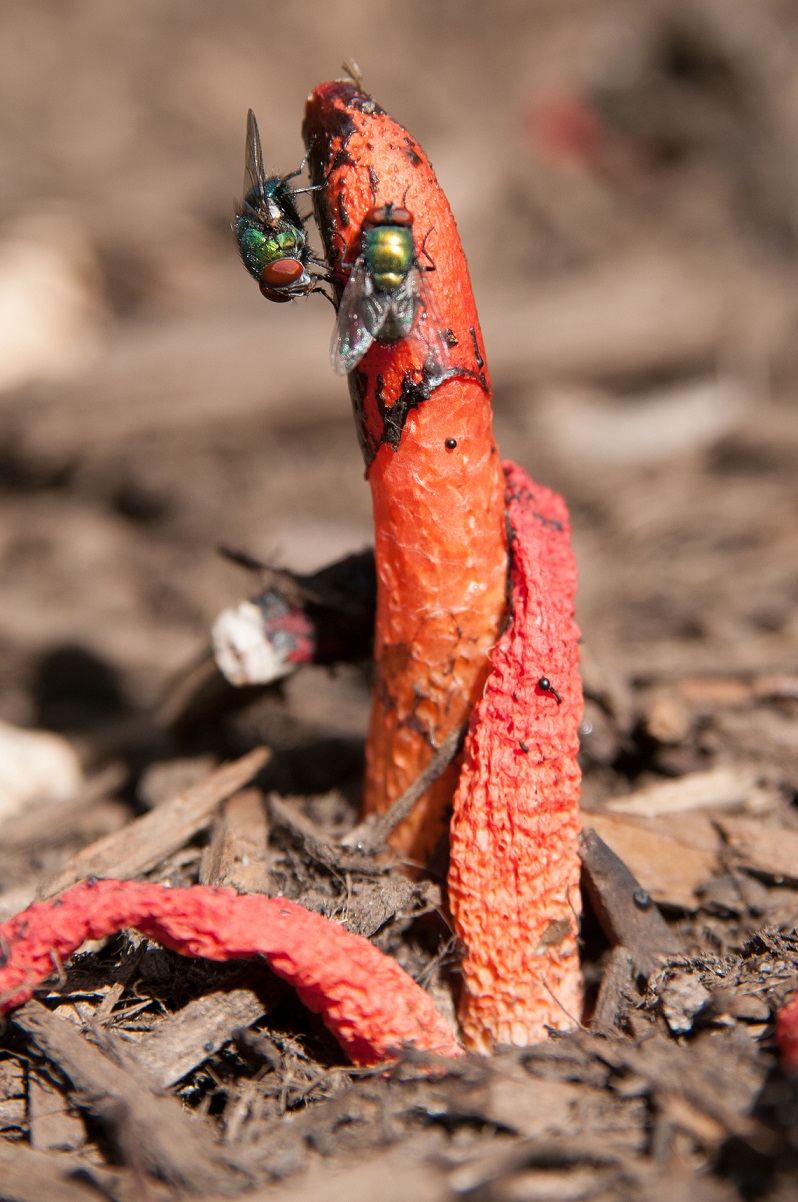
This week we feature a fungus and an insect. The fungus is commonly known as a stinkhorn (Mutinus caninus). The top of the fruiting body (it is a Basidiomycete so it produces a fruiting body aka "mushroom") has a foul-smelling fragrance so that it can attract flies in order to disseminate the spores. These flies look to be greenbottle flies (Calliphoridae) in search of rotting flesh—which is exactly what these fungi smell like. As a Master's student in Microbiology at Seton Hall, I brought in a fresh stinkhorn to mycology class. Dr. Rawn was NOT happy as I proceeded to stink up the entire lab.

This week we feature the broad winged katydid, in the genus Microcentrum. Katydids are in the Order Orthoptera which also includes grasshoppers and crickets. Katydids (also known as bush crickets) can be heard late in summer (and into early fall) usually in the taller trees. They sometimes venture to lower levels (such as this one). When males and females are in copula, the male produces an edible gift, also known as a spermatophylax. This "gift" contains carbohydrates, proteins, and the male’s sperm. The male attaches the nuptial gift to the female just below her ovipositor. Of course, this takes a great amount of the male's energy budget. It is theorized that individuals who produce small spermatophylaxes usually mate more often than males who create large spermatophylaxes. Bigger is not always better. Reference: Welsh, Jennifer. "The Way to a Female Katydid's Heart? Offer Her Food." LiveScience. TechMedia Network, 27 Sept. 2011.
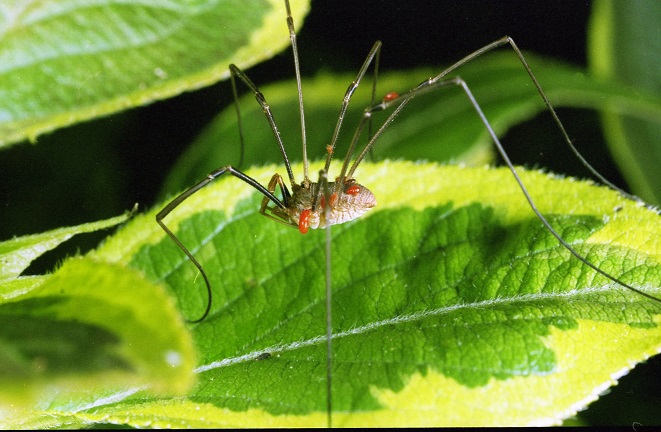
This week we feature two arachnids. The larger specimen here is commonly called "daddy long-legs" in the US. Although these are arachnids, they are not spiders. They are in their own order called Opiliones. This one is parasitized by larval erythraeid mites. Mites are also arachnids but in the order Acari. These mites are in the genus Leptus. The nymphs and adults are predatory and not parasitic. The mites will penetrate the cuticle of the harvestman and feed off of the liquids.
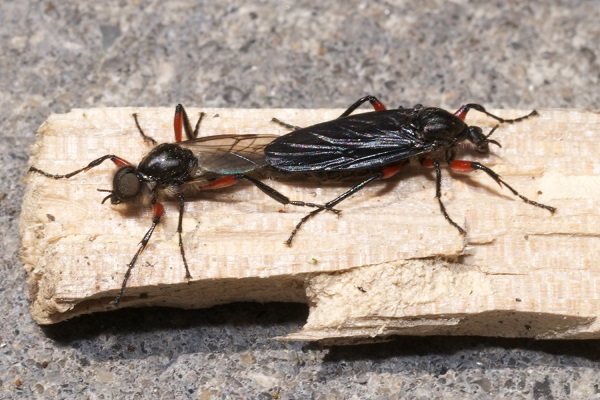
This week's theme is spring. And in the spring most insects are involved with two things: Finding food and reproducing. Here we have what are commonly called "love bugs". They are of course not "bugs", but dipterans in the family Bibionidae. Many people encounter these insects in swarms where they may cover cars as one drives through said swarms. Other common names are bibio flies, march flies or St. Mark's flies. The former common name comes from the fact that the adults usually emerge around St Mark's Day, 25 April. These specimens were photographed on 24-April (the male is on the left with the big compound "so I may see you better" eyes). The term love bug may come from the fact that mating pair may copulate for two to three days.
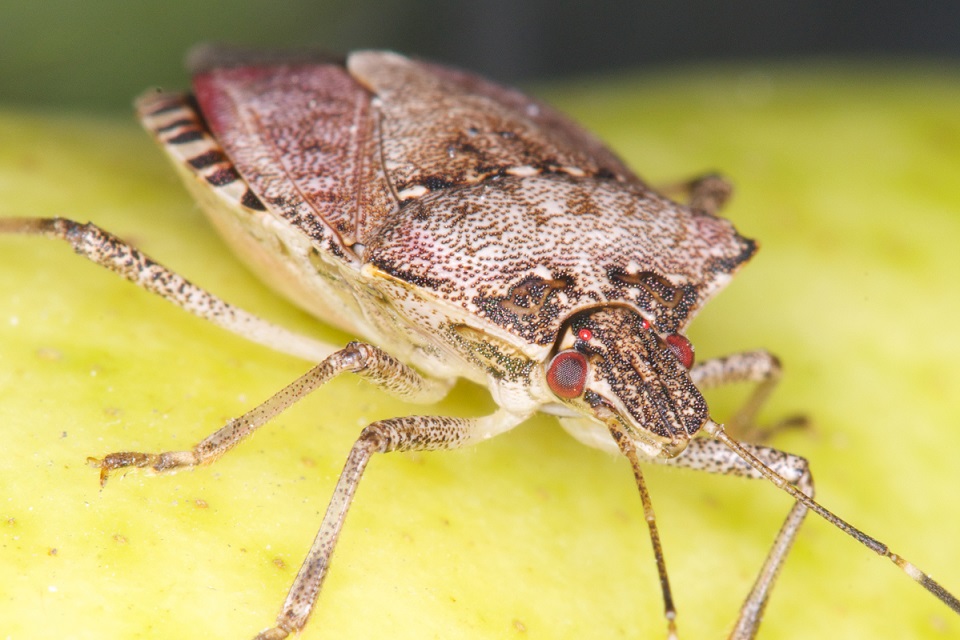
This week we feature an invasive species, the Brown Marmorated Stink Bug (Halyomorpha halys) or BMSB for short. It is a member of the order of true bugs (Hemiptera) and in the family, Pentatomidae (stink bugs). Indigenous to Asia, it was first observed around Allentown, PA in 1996. It's major economic impact is in agriculture where it can cause extensive damage to fruit crops. These specimens were supplied by John Cambridge in the Department of Entomology at Rutgers. For complete information see: njaes.rutgers.edu/stink-bug
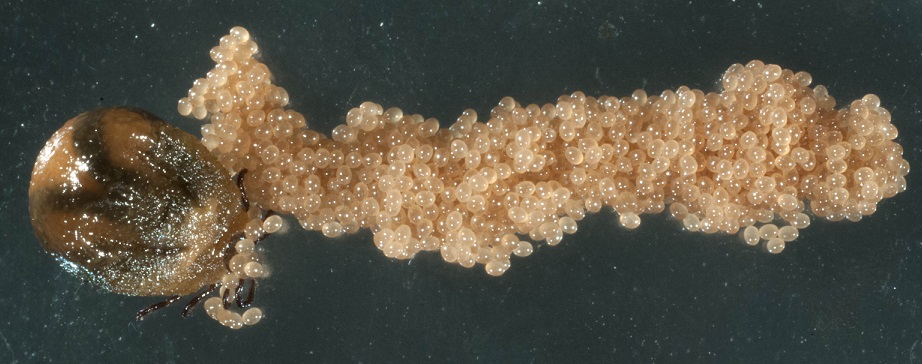
This time around we will feature an arachnid, not an insect. More specifically a tick called the blacklegged tick, Ixodes scapularis. This species of tick can transmit the Lyme spirochete (Borrelia burgdorferi), the agent of babesiosis (Babesia microti), and the agent of anaplasmosis (Anaplasma phagocytophilum) and is very common in New Jersey. This image features a replete and gravid female (fully fed and mated) ovipositing. Females will mate and feed (simultaneously) on their hosts which is usually a large mammal such as a white tailed deer. This particular specimen was removed from a black bear during New Jersey's black bear hunt in December. In the wild, a female may lay up to 3000 eggs that will hatch in August or September. These eggs, which are in my garage, may hatch a bit sooner....
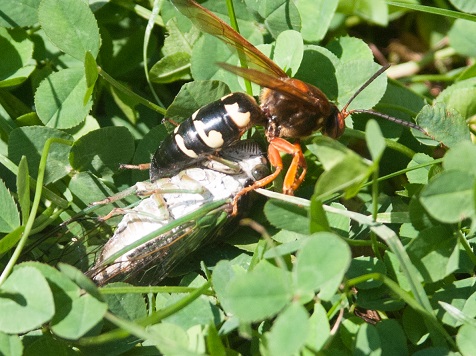
Here we have the cicada killer wasp, Sphecius speciosus, immobilizing an annual cicada (probably of the genus Tibicen). Cicada killers are solitary wasps in the Crabronidae family. The female lays an egg on the immobilized cicada in its nest. But first she must bring the prey to her nest. This is no easy task considering the cicada can weigh more than the wasp itself. Sometimes she has to crawl up the closest vertical object to use as a launching pad. Once in the nest, the wasp larvae will hatch in a few days and penetrate the exoskeleton of the cicada. The larvae will feed on the tissues and overwinter as fully mature larvae. After pupation the following June, the adult emerges in July. Although very large and menacing, the cicada killers are not usually aggressive towards humans and animals.
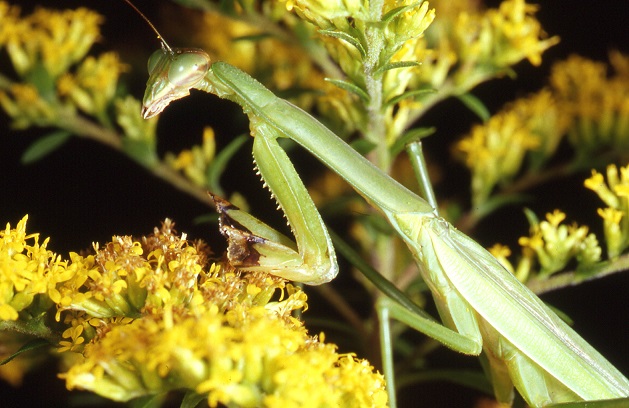
This week features something I observed years ago and captured on film. It's a praying mantis (Order Mantodea, Family Mantidae) with its forelegs severed. Mantises are aggressive hunters and will sometimes attack all sizes of prey as well as their own species. I did not actually witness this event, but I would guess another mantis was the culprit. No doubt this specimen did not survive very long. There are three species of mantises found in New Jersey. This specimen was not identified.
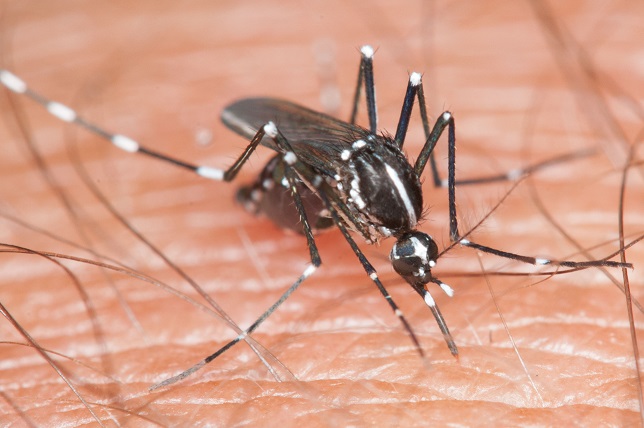
The Asian tiger mosquito (ATM), Aedes albopictus, is thought to have first entered the Gulf coast of the United States in imported tires from its indigenous origin (southern Asia) in the 1980s. By 1985, breeding populations were found in Houston, TX. The first recorded ATM in New Jersey was identified in Monmouth county in 1995.
This image features an ATM feeding on the arm of the photographer, Jim Occi. (Note the photographer's blood in the mosquito's abdomen.)
This mosquito has adapted well to suburban life and can use natural or man-made containers for breeding. It feeds aggressively during the day. It is a known vector of dengue and chikungunya and may be also an important vector of yellow fever and Zika. It was the primary vector of outbreaks of dengue in Hawaii and chikungunya in Italy. For more information see Fact Sheet FS845 from the Rutgers NJAES Website).

Mar 2016—"These images feature Brood II 17-year cicadas photographed in Westfield, NJ in 2013. Adult Magicicada septendecim (Order Hemiptera) emerge after a 17-year dormancy where the nymphs have been feeding on the roots of trees. Featured in this collage is an emerging 4th instar nymph transitioning to teneral adult, a fully emerged teneral adult and a mature adult. For more information, see www.cicadamania.com


